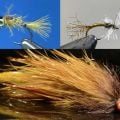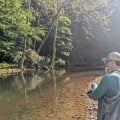How to Tie a Wood Duck Nymph
Producer: Tim Flagler
When I shoot video of mayfly nymphs underwater, their dark markings really stand out. I know that shape, size and color are important for imitating them but markings have got to play a part. The Wood Duck Nymph is kind of the embodiment of this idea, dark markings everywhere. The entire fly is produced using just a single wood duck flank feather along with some gold wire and a wee bit of dubbing.
For a hook, I’m going to use a Fulling Mill 35085 in size 16. After getting the hook firmly secured in the jaws of my tying vise, I load a bobbin with a spool of tan UTC 70 Denier.
Get the thread started on the hook shank leaving an eye-length space behind the eye, and take a few wraps rearward before snipping off the tag. Continue taking wraps, ending with your thread at about the midpoint of the hook shank.
Select a single good looking, long-fibered wood duck flank feather and pull down on the lower fibers to isolate the tip. Then carefully snip that tip off but stash the rest of the feather away in a safe place. The tip will be used to create the tail of the fly. Measure to form a tail a hook shank in length then re-grip the fibers and snip them off about 1/3 of the way down the shank. Give your bobbin a counterclockwise spin so the tying thread will jump slightly rearward as you take the first wrap to secure the fibers to the top of the shank. As you take thread wraps rearward, lift slightly up on the fibers so they get bound down to the top of the shank as opposed to being pushed to the far side of the hook. Continue taking thread wraps all the way back to the start of the hook bend.
Small gold Ultra wire is used to rib and segment the fly. An 8” length is enough to make a few Wood Duck Nymphs. Lay one end of the wire against the near side of the hook so it extends forward to the butt ends of the wood duck. Take nice tight thread wraps to bind the wire to the near side of the hook all the way up to its end. Then wrap rearward and leave your tying thread at about the hook point.
Retrieve your wood duck feather. Leaving a small V at the tip, pull down the remaining fibers on one side of the stem, doing your best to keep their tips aligned in the process. The fibers up at the tip act as a handle so you can pull down on the stem and strip those lower fibers free. Flip the clump around in your fingers so the tips point toward the front of the fly. Place the fibers on top of the hook shank and take thread wraps to anchor the tips. Keep taking thread wraps rearward all the way to the base of the tail. Leaving your tying thread in that location, start taking touching wraps forward with the wood duck fibers but behind your tying thread. This helps to keep the fibers sandwiched together and creates a good looking, slightly tapered body on the fly. When you get about 2/3 of the way up the hook shank, use your tying thread to firmly anchor the fibers, then snip the excess butt ends off close.
Get hold of the gold Ultra wire and start making open spiral wraps with it up the hook shank, effectively counter wrapping the somewhat delicate wood duck fibers beneath. 4-5 turns usually looks pretty good. When you reach your tying thread, loop it around the wire to change the direction of your thread wraps and bind the wire down really well. Once the wire’s secure, again, use it to change the direction of thread wrap. You can then take a few more turns around the hook shank before helicoptering the wire to break it off close.
Pick up what’s left of the wood duck feather. Using the tip fibers as a handle, pull down the remaining lower fibers, perpendicular to the stem. As before, keeping their tips aligned, pull down on the stem to strip them free. Flip the clump around so the tips point forward, and place it on top of the hook shank. A little more than a hook gap length should extend beyond the front edge of the hook eye. Take tight wraps of tying thread to bind the fibers down, first forward to the back of the hook eye then rearward just a bit, like so.
Natural hare’s mask dubbing is used to create the thorax of the fly, a pinch is all it takes. Use the dubbing to build up a slender 1 1/2” noodle on your tying thread. Once complete, start taking wraps with the noodle to produce a nice little thorax on the fly. End with your tying thread slightly back from the hook eye. This space is critical. It allows you to sweep back half the forward pointing fibers along the near side of the hook and bind them down, then do the same with the fibers on the far side. Without that little space behind the eye, this can be difficult to do. The end result should be a roughly even number of fibers swept back on either side of the fly, to represent legs.
Pull the butt ends of the wood duck forward out over the hook eye to form a wing case and bind it down with a few wraps of tying thread. Keeping these wraps back a little from the hook eye will allow you to reach in with your tying scissors and, using the angle of the hook eye as a guide, snip the butt ends off close. To clean things up, lay your tying thread on top of the hook eye and then kind of smear any forward-pointing fibers rearward to clear the eye. Take a few more thread wraps to clean up the head area. Then reach for your whip finish tool and use it to do a 4-5 turn whip finish, seat the knot well and snip or cut your tying thread free.
A drop of head cement, here Sally Hansen’s Hard as Nails, applied to both the wing case and the head of the fly, will really help with durability.
And that’s the Wood Duck Nymph. Markings out the wazoo – on the tail, legs, wing case and abdomen. What could be better?
How to Tie a Wood Duck Heron
How to Tie a Wood Duck Scud











